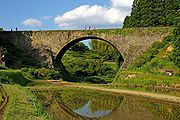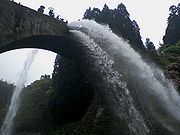
Yasunosuke Futa
Encyclopedia
Yasunosuke Futa was a village chief and also an architect in Kumamoto Prefecture
, Japan
. He built Tsujun Bridge
, which enriched previously barren land. Futa was later enshrined in Futa Shrine in 1937.

 Tsujun Bridge
Tsujun Bridge
is an aqueduct in Yabe, Kumamoto, Japan
. It is an arch bridge
completed in 1854 and is 84m long. The arch spans 27.3m. It is the largest stone aqueduct in Japan. Because the aqueduct was lower than the upper part of the waterway by 6 meters, a reversed siphon mechanism works when water is allowed to flow through the aqueduct. The stone aqueduct was made watertight with mortar. In order to keep the aqueduct in working condition, and for viewers such as tourists, water is poured into the river once in a while.
For 7 years, Futa had saved money for the construction, but he had to get the approval of his superiors. Because Futa was a village chief, he could not attend the budget conference of Higo Province, but his superiors such as Gennosuke Mano (Oometsuke) and Han-emon Kouzuma (Gundai) attended. Lord Hosokawa allowed stone technicians to study the framework of Kumamoto Castle, which was exceptional.
Futa used his own money to send teams of technicians, such as Kangoro Hashimoto and Sangoro Iwanaga, to Nagasaki and Bungo to study the construction of arch bridges.
150,0000,000, according to Seiki Ishii. This estimate is based on the direct cost of 710 Kan; this is roughly the same as 800 Kan which was the direct cost of Lord Shigekata Hosokawa traveling with a little less than 1000 followers to Osaka for Sankin kotai
(alternate attendance).
Kumamoto Prefecture
is a prefecture of Japan located on Kyushu Island. The capital is the city of Kumamoto.- History :Historically the area was called Higo Province; and the province was renamed Kumamoto during the Meiji Restoration. The creation of prefectures was part of the abolition of the feudal system...
, Japan
Japan
Japan is an island nation in East Asia. Located in the Pacific Ocean, it lies to the east of the Sea of Japan, China, North Korea, South Korea and Russia, stretching from the Sea of Okhotsk in the north to the East China Sea and Taiwan in the south...
. He built Tsujun Bridge
Tsujun Bridge
Tsūjun Bridge is an aqueduct in Yamato, Kumamoto, Japan. It is an arch bridge completed in 1854 and is 84.0m long. The arch spans 27.3m...
, which enriched previously barren land. Futa was later enshrined in Futa Shrine in 1937.
History
At age 23, Futa became acting village chief by birth. At age 30, he was given money for developing new rice fields. At age 32, he became the full village chief; at that time, villages were very large. At age 34 he was given a prize because his area did not experience the nationwide famine. At the age of 52, he started to build the Tsujun Bridge. It was completed on July 29, 1854, when he was 54 years old. He remained village chief until the age of 61. In 1868, he was given a prize by Lord Hosokawa for the bridge. On April 3, 1873, he died.Tsujun Bridge


Tsujun Bridge
Tsūjun Bridge is an aqueduct in Yamato, Kumamoto, Japan. It is an arch bridge completed in 1854 and is 84.0m long. The arch spans 27.3m...
is an aqueduct in Yabe, Kumamoto, Japan
Japan
Japan is an island nation in East Asia. Located in the Pacific Ocean, it lies to the east of the Sea of Japan, China, North Korea, South Korea and Russia, stretching from the Sea of Okhotsk in the north to the East China Sea and Taiwan in the south...
. It is an arch bridge
Arch bridge
An arch bridge is a bridge with abutments at each end shaped as a curved arch. Arch bridges work by transferring the weight of the bridge and its loads partially into a horizontal thrust restrained by the abutments at either side...
completed in 1854 and is 84m long. The arch spans 27.3m. It is the largest stone aqueduct in Japan. Because the aqueduct was lower than the upper part of the waterway by 6 meters, a reversed siphon mechanism works when water is allowed to flow through the aqueduct. The stone aqueduct was made watertight with mortar. In order to keep the aqueduct in working condition, and for viewers such as tourists, water is poured into the river once in a while.
Factors of Futa's success
Before construction of the Tsujun Bridge, Futa had completed a number of construction works including bridges, and already had a great reputation.Achievements of Yasunosuke Futa
- Roads, 320 places
- Distance of new roads: 28 Ri (Ri=about 4 km)
- Stone pavements, 21 places (1440 Ken) (Ken=1.8m)
- Stone bridges, 2
- Waterways, 194 Ken
- Highways, 23 places (9066 Ken)
- Village roads, 48729 Ken
- Arch bridges, 13 bridges (second largest is over Sendai River)
- Banks, 7 places
- Ide, 15181 Ken
- Stone masonry, 35 places
For 7 years, Futa had saved money for the construction, but he had to get the approval of his superiors. Because Futa was a village chief, he could not attend the budget conference of Higo Province, but his superiors such as Gennosuke Mano (Oometsuke) and Han-emon Kouzuma (Gundai) attended. Lord Hosokawa allowed stone technicians to study the framework of Kumamoto Castle, which was exceptional.
Futa used his own money to send teams of technicians, such as Kangoro Hashimoto and Sangoro Iwanaga, to Nagasaki and Bungo to study the construction of arch bridges.
Cost of construction
The cost of construction was ¥Japanese yen
The is the official currency of Japan. It is the third most traded currency in the foreign exchange market after the United States dollar and the euro. It is also widely used as a reserve currency after the U.S. dollar, the euro and the pound sterling...
150,0000,000, according to Seiki Ishii. This estimate is based on the direct cost of 710 Kan; this is roughly the same as 800 Kan which was the direct cost of Lord Shigekata Hosokawa traveling with a little less than 1000 followers to Osaka for Sankin kotai
Sankin kotai
was a policy of the shogunate during most of the Edo period of Japanese history. The purpose was to control the daimyo. In adopting the policy, the shogunate was continuing and refining similar policies of Toyotomi Hideyoshi. In 1635, a law required sankin kōtai, which was already an established...
(alternate attendance).

